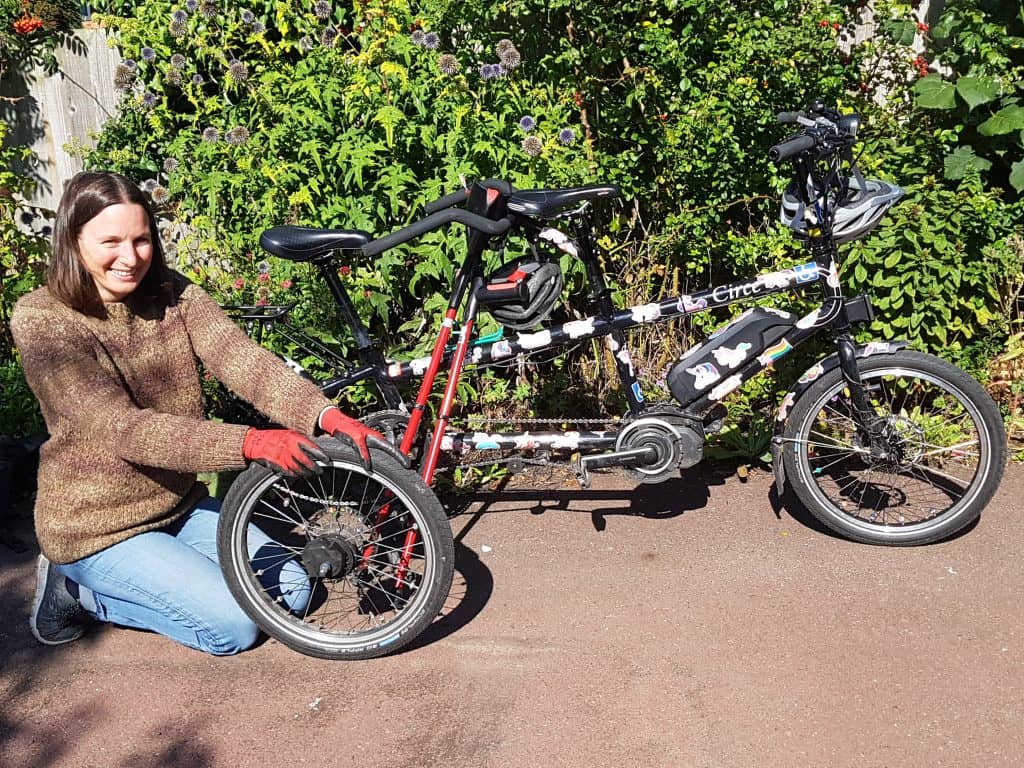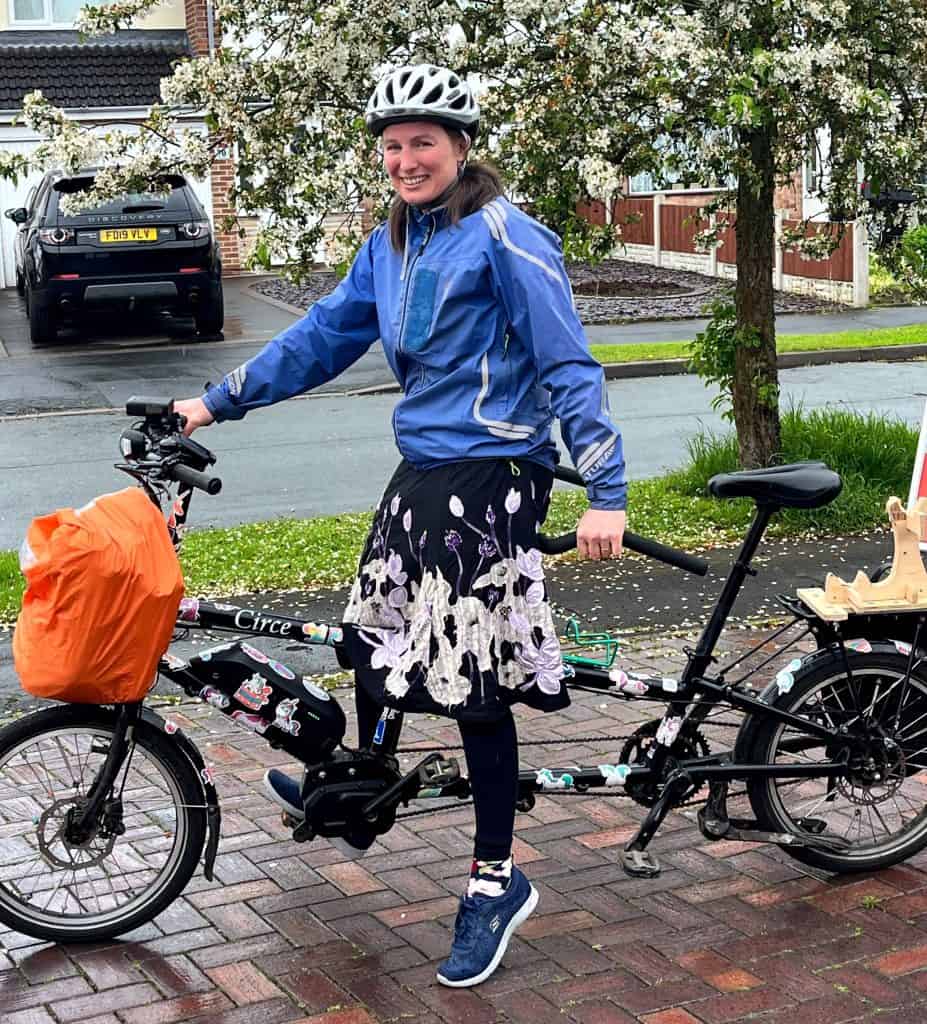We love cycles and we love people’s cycle stories. Our Staff and Trustees share our passion, and we wanted to share it with you too! Our Cycle Stories is a new blog series devoted to introducing you to our wonderful team, and the diverse and varied ways that cycling has become an enriching part of their lives.
What is your name, and what do you do at Wheels for Wellbeing?
I’m Kate Ball, I’m one of the Campaigns and Policy Leads. I lead on most of the technical nerd stuff – I genuinely think things like gradients and turning circles and how different people need to move when using different devices are really interesting!
What has been your career trajectory; how did you come to end up working at WfW?
I have bit of an unusual career trajectory! I got a degree and did a PGCE, then worked as a secondary science teacher. Then we had two babies, so I worked as a childminder and did volunteering including cycling and environmental campaigning to stay at home with them.
Then we had two more children, who have turned out to need higher levels of support than average, so I was out of paid employment for about 9 years. And in 2020, I also became Disabled with what was thought to be something that would resolve within a year or so, but unfortunately has turned out not to be.
I did quite a lot of accessibility and Active Travel work locally over the years – there’s a barrier on a cycle track which was removed about a year ago, which I first asked to have removed in 2010, because it was completely impossible to get a child trailer through and I’d met mobility scooter users who were frustrated by it, too. I’m really glad it’s gone now – although more have been built in other places…
Anyway, in 2022, I was talking with someone from Wheels for Wellbeing about various inclusive cycling issues – they mentioned that there were jobs being advertised for Campaigns and Policy Officers, asked if I would consider applying. We’d finally got our children’s Education, Health and Care Plans (EHCPs) sorted out, so had the capacity to start part-time work again. I applied for the job, and have been working for Wheels for Wellbeing for about 2 ¾ years now.
Do you use a cycle? What/how/where?
Yes! I ride most days, generally utility cycling (making journeys for a purpose other than the journey) but also for leisure.
I ride a Circe Helios e-tandem mostly – either on my own or with one of my children. Yes, you can ride a tandem solo! Technically the tandem belongs to my daughter, who is also Disabled, but everyone likes riding it. It’s our main vehicle for getting around where we live because it’s so much faster and more convenient than other options. We use it for school runs, shopping, getting to clubs – everything within a 5 mile or so radius, really. We’re in a city, so that’s pretty much everything. The brilliant Brian from Remap even made a mount for the rear pannier rack, which carries my wheelchair. If I’m only expecting to walk really short distances from cycle parking, my foldable crutches also fit into a bike pannier. I need e-assist on any cycle I use, as otherwise I can only ride downhill…
I also have a secondhand Brompton with a Swytch kit e-assist conversion. I use that when travelling by train for work. I can also tow my wheelchair behind it, which is good for going to places where roads or terrain are too difficult for my wheelchair alone – although towing wears the wheelchair tyres horribly. I also use it for some solo riding, especially accompanying my daughter on her trike.
Adventures like going over the Roaches, even with lots of assistance from my husband and two large teenagers, was… perhaps a bit too optimistic and not an experience I’m going to repeat. But the Brompton worked really well for things like “hiking” with family around Ladybower, Derwent, and Howden reservoirs over the Easter weekend. It’s not as nice to ride as the Helios, though: even though the Helios is much bigger and heavier, it has a much better e-assist and is comfier, and weirdly because the e-assist is better, I both get more exercise and end up in less pain. There are definitely huge differences between different e-cycle types – and it’s not always the ones you’d expect to be easier to ride that will be!
And I’ve borrowed a whole lot of different types of e-cycles for all sorts of riding – mostly bikes. Highlights included a side-by-side tandem which was great fun and had a powered reverse gear, and an e-assist mountain trike, which has lots of cycle parts but is more like a wheelchair in most ways. The mountain trike was fantastic for getting around beaches, at least on wet sand, and over all sorts of countryside.
What does cycling mean to you, and your overall wellbeing?
My lifestyle pretty much depends on cycling! I get stuck if the tandem needs a service or anything, because I’m suddenly able to do much less and have to limit activities and find people to help out a lot more. That basically means limiting myself and the children to only doing things outside the house which fit in with other adults’ schedules.
Something which I’ve found really difficult since becoming Disabled is working out what I can do to get to and around most of the places I could when non-disabled, especially accompanying children who need close supervision and support. I’ve been incredibly privileged in that I was already an experienced cyclist before becoming Disabled, and that I can afford mobility aids that work for me. I have all sorts of things, including my crutches, wheelchair, e-tandem, and e-converted Brompton. In the past we had a rear-steer tandem, which was great for our daughter to learn to ride but was very heavy and had no e-assist: once she was safe to sit on the back of a tandem we were able to upgrade to our current e-tandem.
Cycling means I can get to places I need to go to with a minimum of fuss, delay, and pain. I do drive, but it’s far less practical than cycling for most trips. For example, on school runs, if I try to drive, it’s really hard finding parking. Then I need to use my wheelchair to get to the school gate, but other parents often park their cars blocking all the dropped kerbs and zoom around corners. Using a car and wheelchair is slow, exhausting, dangerous and upsetting. But cycling I can roll straight to the school gate and don’t even need to dismount. And the drivers tend to spot me cycling even though they often don’t spot me when I’m using my wheelchair.
Of course, there are plenty of times when inaccessibility still causes a lot of issues: getting into some schools is an astonishingly miserable experience – how is it that schools are allowed to be inaccessible?! But having e-assist cycles as my main mobility aid means I have way more freedom and independence than any other options would give me.

Do you have a favourite session, route, or adventure?
I love cycling around Gower when we visit family as the roads are really quiet, at least as long as you don’t hit the main roads at peak getting-to-the-beach times! The 20mph default speed limits in Wales have made everything so much calmer and nicer. It feels like there’s loads more respect between different road users now than there used to be a few years ago, which makes the single-track road feel really safe and relaxing to ride on for me. The Gower is gorgeous – usually I borrow my mum’s e-bike but sometimes we’ve brought the Helios tandem with us. We can go exploring all over the place.
I also love cycling in central London, which often surprises people! But it’s the same thing – 20mph speed limits and many of the streets are either quite quiet, or have protected cycle tracks, so it feels way safer than cycling in many other places. And I get lost with diversions around roadworks or just because a road looks nice, so I go down it pretty well every time I visit, so I get to find all sorts of interesting places!
Is there anything that you think WfW does better than anyone else?
Like other Disabled People’s Organisations, we’re really focused on ensuring accessibility in everything we do, and a big part of that is collaboration, listening, and learning. I think we’re really good at working with other DPOs, Disabled individuals and wider organisations to develop best practice.
Wheels for Wellbeing have influenced a lot of thinking nationally: it’s great that attitudes around things like barriers on cycle tracks are changing, with national cycling infrastructure guidance across the UK recommending removal and emphasising the need for routes to be accessible. I think Wheels for Wellbeing have been a really large part of that change – we’re a small organisation but we have a good reputation for listening and promoting positive, equitable solutions, which means people tend to listen to us.
I think we’re the leading DPO for walking/wheeling and cycling specifically, and that we partner well with Transport for All and other organisations, especially on public transport and multi-modal journey considerations.
The areas I think we’re producing thought-leading work on are around developing policies and legislation for Active Travel and multi-modal journey making accessibility, and around developing principles for creating accessible, inclusive public spaces of all kinds. There are many organisations working on public spaces and transport, but our lived experience and focus on accessibility means we’re often able to articulate needs and issues with designs in ways that help with understanding and leading the way to create practical solutions.
If you had a magic wand, what one thing would you change in #ActiveTravel #InclusiveCycling to benefit Disabled people, their mobility, and their wellbeing?
This is a really powerful magic wand, right?
Can I have continuous walking/wheeling and cycling routes from everyone’s front door to everywhere they want to go – including safe crossings over all roads and through all junctions please?
Then we’ll need to make sure everyone has enough money and support to get whatever mobility aids work best for them – and make sure people have accessible storage and charging. And comprehensive public transport that runs regularly enough and for long enough hours on enough routes that it’s a viable alternative to using private cars for most people.
I think if all the routes could appear right away as a first step, that would make things so much better for everyone instantly and hopefully would change a lot of people’s opinions about usability of active travel. But given I do mostly infrastructure work, I would say that!

